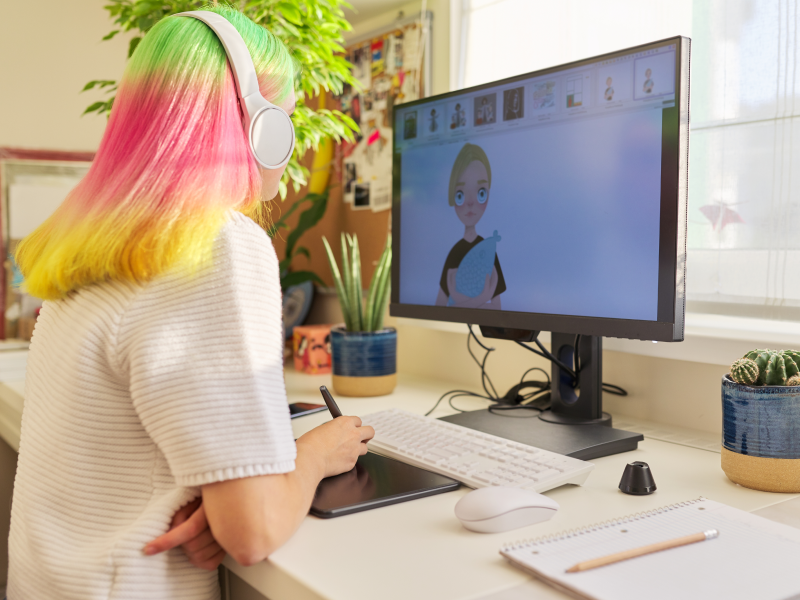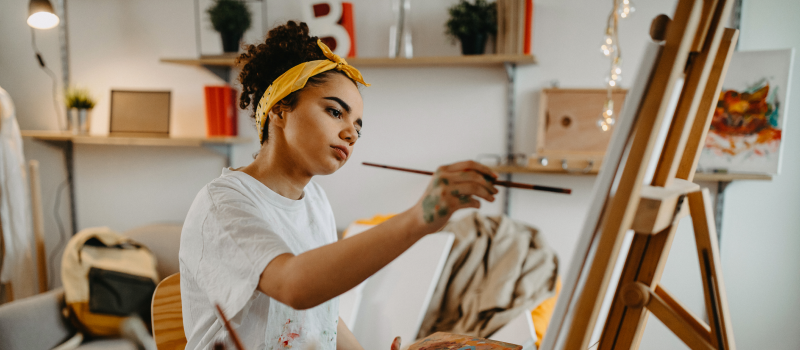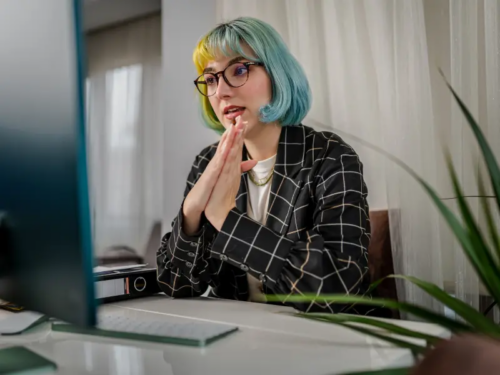
Table of Contents
Ask a Clinician: How Does Art Therapy Work?

Written By: Dr. Rasna Kaur Neelam
March 13, 2023
5 min.
Art therapy is a core component of our virtual IOP at Charlie Health. Hear from one of our art therapists about how art therapy is effective from home.
Learn more about our Clinical Review Process
Table of Contents
Art therapy is a modality used by licensed clinicians to help clients manage a multitude of mental health concerns. In this article, Charlie Health spoke with practicing art therapist, Jenny Leon, to learn more about the field.
Please introduce yourself to our readers. What has been your interest and experience in art therapy?
My name is Jenny Leon, and I have been practicing art therapy for close to 3 years. I graduated from Pratt Institute with a Masters in professional studies with a concentration in Creative Arts Therapy and Creative Development.
Since graduating, I’ve worked with various populations (including the elderly, adults, adolescents, and young children) within different settings ranging from residential programs, homes, and schools.
Although I’ve worked with many different populations, I have a passion for working with trauma survivors as I am a trauma survivor myself and I’ve seen the benefits of utilizing art-making as a form of healing.
What is art therapy?
Art therapy is a practice within behavioral healthcare that enhances the lives of individuals, families, and communities through active art-making, creative processes, applied psychological theory, and human experience within a psychotherapeutic relationship.
Art therapy can be used across all ages, genders, disabilities, and mental health disorders. Art therapy is very welcoming as it’s tailored to each individual’s abilitie and needs.
What happens in art therapy?
When clients come into an art therapy session, they participate in art-making by utilizing readily-available materials either provided by the art therapist or brought by the client.
Art therapy utilizes all forms of art such as drawing, painting, sculpting, collaging, poetry, doll-making, and more. The art therapist will assist the client in determining what materials and form of art would be best fitted to assist with reaching their mental health treatment goal.
Art-making is used to support the client’s healing journey by either promoting insight, gaining self-awareness, or learning a new coping tool. After the art-making process, and with the assistance of the art therapist, the client will spend time processing and discussing their artwork.
Join the Charlie Health Library
Get mental health updates, research, insights, and resources directly to your inbox.
You can unsubscribe anytime.
How long does this form of therapy usually last? Are the sessions different each time?
Each session may vary depending on the client and the setting but an art therapy session can last from 50-90 minutes.
What are the goals of art therapy?
The goal of art therapy is to support personal treatment goals by:
- Improving cognitive and sensorimotor functions
- Fostering self-esteem and self-awareness
- Cultivating emotional resilience
- Promoting insight
- Enhancing social skills
- Reducing and resolving conflicts and distress
- Advancing societal and ecological change

Are there any other forms of therapy that art therapy overlaps with?
Since art therapy is a mental health profession, an art therapy session can be seen overlapping other forms of therapy such as psychodynamic therapy, humanistic therapy, cognitive behavioral therapy (CBT), and dialectical behavioral therapy (DBT).
Is art therapy more helpful for individuals with certain types of struggles, medical diseases, or mental health disorders? Certain ages, genders?
Art therapy can be helpful for all regardless of age, gender, struggles, illness, or mental health disorder but it can definitely be helpful for those struggling overall. It can be used to access and express aspects about ourselves that could be difficult to articulate.
Does a client need to be artistically inclined or “good at art” to participate?
Clients are not required to be artistically inclined or be good at art in order to participate. My motto for any client who comes into a session with the misconception that they need to be good at art is, “There’s no right or wrong way to do art.”
Can this form of therapy be completed in groups?
Absolutely! You actually see art therapy be done more in groups, especially in treatment facilities than individual sessions but it can be done both individually and in groups.
Do you need more support with
your mental health?
Charlie Health can help.
Are there any risks or downsides of art therapy?
I genuinely believe there’s no downside or risks of doing art therapy, only a newfound appreciation of the benefits to art therapy and art-making to their mental health.
Should art therapy be completed in conjunction with other therapy or supportive devices?
I believe art therapy should be used in conjunction with other therapy, as it can be beneficial to the client’s overall well-being and ability to reach their goals.
What qualifies someone to lead art therapy? Are there certain exercises that can be done at home without the supervision of a clinician?
To lead an art therapy session, the therapist must be registered by the Art Therapy Credentials Board and have either an ATR-P, ATR, or ATR-BC licensure in order to be deemed as a qualified art therapist.
However, there are art exercises that clients can participate in without the supervision of a clinician, such as creating or coloring in mandalas, creating collages, or any other art exercises that can be used as coping tools.
How can art therapy be done virtually?
Virtual art therapy can be done through the use of webcams. Clients will either provide their own art supplies, or the art therapist will supply them with supplies prior to the session. The session is done in the same fashion as it would be done in person; clients will participate in art-making and process the artwork with the art therapist.
Art therapy at Charlie Health
If you think art therapy might be a useful tool for yourself or a loved one, reach out to get signed up today. Trained clinicians offer both music and art therapy, in conjunction with many of the other forms of therapy described above.





